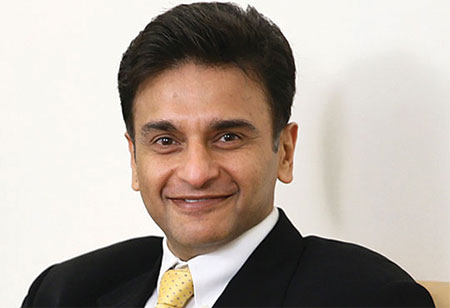SAP Solution: An Outlook
By Jay Shah, Associate VP and Enterprise Applications Head - Nihilent Technologies
 SAP is #1 in the ERP market and has over 24 percent of world market share of the ERP business. SAP has 320,000 customers in 190 countries with annual revenue exceeding 23 billion USD. Its customers include 87 percent of Forbes global 2000, 98 percent of 100 most valued brands. 78 percent of world’s transaction revenue touches an SAP system. SAP specializes in applications, analytics and mobility solutions and is the fastest growing database vendor.
SAP is #1 in the ERP market and has over 24 percent of world market share of the ERP business. SAP has 320,000 customers in 190 countries with annual revenue exceeding 23 billion USD. Its customers include 87 percent of Forbes global 2000, 98 percent of 100 most valued brands. 78 percent of world’s transaction revenue touches an SAP system. SAP specializes in applications, analytics and mobility solutions and is the fastest growing database vendor.
Functions and Processes
A typical business may consist of the following departments or functions: Sales and Marketing, Purchase and inventory management, production planning, Finance and Accounting, Warehousing and Dispatch, HR. In line with these functions, the core of SAP ERP contains the following modules
• Sales and Distribution (SD) and Customer relationship management – (CRM)
• Material Management -MM (Purchase Management and Inventory management)
• Finance and Controlling – FICO (Accounting, Finance, Cost/profit center accounting)
• Production Planning – PP
• Quality Management (MM)
• Plant Maintenance - PM
• Project Systems – PS (Managing projects)
Implementation of these functional modules requires trained SAP functional consultants. This, in turn, are exciting career opportunities to specialize in respective modules.
The most current version of SAP’s original ERP solution is the ECC 6.0 introduced in 2006. Subsequently the ERP solution has been enhanced via enhancement packs, the latest being Ehp 8. ECC 6.0 was preceded briefly by ECC 5.0. Previous versions, known as R/3 include release 4.70, release 4.6c, going back to 1998 for release 4.0.
To overcome siloes within an organization, SAP supports process centric approach that transcends functional/departmental boundaries. SAP supports most of these processes including :
• Order to Cash
• Procure to Pay
• Plan to Product
• Request to Service
• Record to Report
• Produce to Deliver
• Hire to Fire
The core ERP – ECC 6.0 has grown on multiple fronts –helping organizations reach out to customers, vendors, employees, and new products development. Accordingly extending the core ERP application are business applications such as CRM, SRM, HCM and PLM. In addition, to address industry specific processes, SAP also has Industry specific solutions (IS) for 25 different industries.
Technical aspects of SAP
SAP’s ECC application covers vast functionalities not all of which are required by every organization. Hence, the solution is tailored to each company’s requirements via specifying the necessary options, also termed as “configuration”. At the same time, if there are business requirements that cannot be met via configuration, SAP offers a complete development platform and its proprietary development language, ABAP, to develop custom objects. Other technical areas include SAP BASIS, SAP Security, and SAP Exchange Infrastructure – now rechristened SAP PI, among others.
Each of the above offers career opportunities as a Technical SAP consultant.
Business Intelligence
An ERP solution is ideally suited to record business transactions and provide reports thereon. However, when it comes to complex analysis, the ERP solution encounters performance challenges. A business intelligence (BI) solution helps overcome this challenge. SAP’s BI solution consists of a Data Ware house application, called the business warehouse with ETL capability extracting data from the ECC 6.0 application. SAP also offers a complete suite of analytical tools to present the data that is extracted from the Business Warehouse, in the form of graphs, charts, tables and complex interactive dashboards that enable insightful business decisions.
Newer Developments
From a functionality perspective, SAP ERP solutions continue to grow. It has added modules such as e-commerce (HYBRIS), e-Procurement (ARIBA), e-HR (Success Factors), e-travel management (Concur), Budgeting and financial consolidation (BPC), Governance, Risk and Compliance (GRC), and many more. Today, the SAP catalogue has over 3000 line items.
On the technical side, SAP has introduced HANA. HANA is an in-memory computing appliance that delivers performance that is higher by many orders of magnitude. HANA has been used extensively in the Business Intelligence space. HANA is also a database and has now become the de-facto database platform for SAP’s new or upgraded solutions. HANA also enables SAP’s numerous Cloud offerings.SAP has also re-written its ERP suite – ECC 6.0 to leverage the power of HANA and rechristened it S/4 HANA. The user interface for S/4 HANA has been redesigned to provide superior user experience on large and small screens. S/4 HANA has a compact footprint than its predecessor, which improves performance and utilizes the power of HANA to deliver exceptional experience.
SAP in India
In India too, large manufacturing organizations mostly prefer SAP as it is ideally suited for both discrete and process manufacturing organizations. Industries include Automotive, Oil & Gas, Consumer Products, Industrial Machinery and Components, Utility, Chemicals, Pharmaceutical, as well as some government bodies. SAP is seeing a lot of traction for its core ERP solution, the reimagined S/4 HANA, BI on HANA, Cloud solutions, Process Integration, ABAP services among others. SAP has succeeded in acquiring the largest market share in India’s ERP market as well.
In conclusion
SAP is riding the digital transformation wave aggressively. It is investing billions in the IoT space, and has made large acquisitions in cloud-based solutions. Its HANA platform is already creating ripples across the industry. SAP continues to extend its leadership in the business applications space.
Explanatory note for the image
The grid at the centre depicts the core functionalities within an organization, while SAP’s core modules that support those functions are listed below the grid. The other images are some of SAP’s new dimensional solutions.




